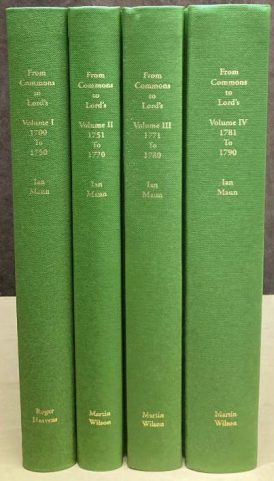From Commons to Lord’s
Martin Chandler |Published: 2021
Pages: 412
Author: Maun, Ian
Publisher: Martin Wilson
Rating: 4 stars

The sub-title to the book I opened first before starting this review is Volume IV 1781-1790, but to all intents and purposes this is a look at all four books in the series. Volume I, covering 1700-1750, was published by Roger Heavens back in 2009 and runs to 259 pages. For Volume II, covering 1750-1770, the publishing baton passed to Martin Wilson, and that appeared in 2011 and has 252 pages. There was then a five year wait for Volume III, that one covering just a single decade, but extending to 315 pages.
The steadily increasing size of the books, coupled with the reducing periods which they cover, demonstrates the game’s growth over the course of the 18th century. I understand that Volume V will cover only five years, thus leaving the way clear for a Volume VI to conclude Maun’s work. It is hoped that the next twelve months will see the substantially completed Volume V emerge.
Ian Maun is (now) a retired university lecturer. His mission statement has been to investigate the game as it was played and referenced in contemporary writing in the 18th century. By the end of the 1700s the glory days of Hambledon were well underway, although it would be 1833 before John Nyren produced his groundbreaking The Cricketers of my Time, published with The Young Cricketer’s Tutor. There are few familiar names in From Commons to Lord’s until Volume IV, but here the names of David Harris, John Small and William ‘Silver Billy’ Beldham emerge. It is a nice touch that the foreword to Volume IV has been contributed by Beldham’s oldest surviving male descendant.
Cricket in the 1700s is a subject that has been extensively studied in the past, noted students of the game who have published books being HT Waghorn and GB Buckley. Much work was also done by others, not least by the doyen of them all, FS Ashley-Cooper, so Maun has not unearthed a previously undiscovered country, but he has sought to provide researchers with a single coherent source.
It will come as no surprise that the entries in the book are strictly chronological and cover an array of reports from a wide range of publications. Where earlier historians have previously discovered the entries they are meticulously cross referenced and, where necessary, corrections are made to what has appeared in print before.
Against that background there is no sort of seamless narrative, and much of the writing is the straightforward reciting of facts, albeit with some curious period touches at times. Biographical details of the players are few and far between, and descriptions of the play are nothing like the sort of reportage that in the following century or so would become the norm. The language can be unusual as well, runs being known as ‘notches’ for many years.
The laws of cricket, such a detailed code in modern times, make for interesting reading and each of the four volumes contains, in one of the appendices, a version of the laws, respectively 1727, 1755, 1774 and finally 1788.
Where, in those times, matches were described verse was generally the favoured format. In Volume I probably the most famous poem of them all is reproduced in full, Cricket: An Heroic Poem, by James Dance (Love), which was first published in 1744 and which describes a famous encounter between Kent and England that was played at the Honourable Artillery Company Ground in Finsbury Park. The match was won by Kent by a single wicket. Other poems and songs feature as well and are also reproduced in an unabridged form, including one brief verse from the pen of William Blake, not a man normally associated with the game of cricket.
So is Ian Maun’s body of work something to purchase? The answer to that one is that it is only going to be of interest to either bibliophiles, historians, or those of us who are a bit of both. The fourth volume is, at £145, an expensive purchase, albeit it is an attractive book, printed on high quality paper and with its illustrations very well presented. The four books are all bound in identical style so, if you are going to get one then you are going to want all four, and although the slightly slimmer first three volumes are all a little cheaper, any buyer will still have to part with a tidy sum. For those who like this sort of thing however, these books are certainly a worthwhile investment.







Leave a comment